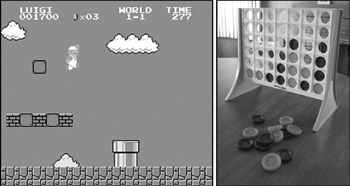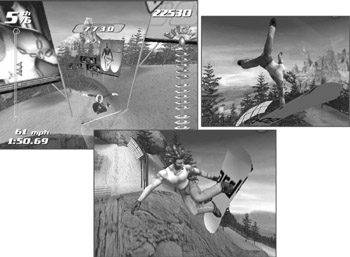Procedures
|
| < Day Day Up > |
|
Procedures are the methods of play and the actions players can take to achieve the game objectives. One way to think about procedures is: who does what, where, when, and how?
-
Who can use the procedure? One player? Some players? All the players?
-
What exactly does the player do?
-
Where does the procedure occur? Is the availability of the procedure limited by location?
-
When does it take place? Is it limited by turn, time, or game state?
-
How do players access the procedure? Directly, by physical interaction? Indirectly, through a controller or input device? By verbal command?
There are several types of procedures that most games tend to have:
-
Starting Action: How to put a game into play.
-
Progression of Action: Ongoing procedures after the starting action.
-
Special Actions: Available conditional to other elements or game state.
-
Resolving Actions: Bring gameplay to a close.
In boardgames, procedures are explained in the rules document. In digital games, they are described in the control section of the manual. Procedures are much easier to distinguish in digital games because they are the things the player does with the controller. Here are some examples of procedures from both a board/tabletop game and a digital game.
Connect Four
-
Choose a player to go first.
-
Each player in his turn drops one of his color checkers down any of the slots in the top of the grid.
-
The play alternates until one of the players gets four checkers of his color in a row. The four in a row can be horizontal, vertical, or diagonal.
Super Mario Bros.[3]
Select Button: Use this button to select the type of game you wish to play.
Start Button: Press this button to start the game. If you press it during play it will pause/unpause the game.
Left Arrow: Walk to the left. Push button B at the same time to run.
Right Arrow: Walk to the right. Push button B at the same time to run.
Down: Crouch (Super Mario only).
A Button
Jump: Mario jumps higher if you hold the button down longer.
Swim: When in water, press this button to bob up.
B Button
Accelerate: Press this button to run. If while holding B, you press A to jump, you can jump higher.
Fireballs: If you pick up a fire flower you can use this button to throw fireballs.

Figure 3.21: Super Mario Bros. and Connect Four
Comparison
Notice that both Connect Four and Super Mario Bros. specify a starting action. The 'progression of action' in Connect Four is clearly shown in steps 2 and 3, while in Super Mario Bros., which is a real-time game, the progression is implied by the left and right walk commands, which move the player through the game. Connect Four doesn't have any 'special actions,' but Super Mario Bros. has commands that are only applicable in certain situations: i.e., 'when in water press this button to bob up,' and 'if you pick up a fire flower, you can use this button to throw fireballs.' Connect Four also states the resolving action: when one player gets four checkers in a row. Super Mario Bros. does not state the resolving action; this is because the resolution is adjudicated by the system, not the players.
Exercise 3.5: Procedures for Blackjack
List the procedures for blackjack. Be specific. What is the starting action? The progression of action? Any special actions? The resolving action?
System procedures
Digital games can have much more complex game states than nondigital games. They can also have multifaceted system procedures that work behind the scenes, responding to situations and player actions. In a role-playing combat system, character and weapon attributes may be used as part of a system calculation determining whether a particular player action succeeds, and if so, how much damage it causes. If the game were to be played on paper, as many role-playing games are, these system procedures need to be calculated by the players, using dice to generate random numbers. If the game is played digitally, the same system procedures are calculated by the program rather than the players.
Because of this, digital games can involve more sophisticated system procedures and process them more quickly than nondigital games. This does not mean that digital games are 'more complex' than nondigital games. When we discuss system structures in Chapter 5 on page 112, we'll look at systems that have simple procedures, which lead to extremely complex results. For example, games like chess or Go are nondigital systems that have intrigued players for thousands of years with their innate complexity, all of which stems from the relationship of very simple game objects and the procedures for manipulating them.
Title: Game Developer, Mind Control Software
Project list (five to eight top projects)
-
Thief series
-
System Shock series
-
Ultima Underworld II
How did you get into the game industry?
When I went to school at MIT, I lived on 41st West, a dormitory hall that was home to a number of quirky individuals. Around 1990, several of my 41st West friends (including Dan Schmidt, Jon Maiara, James Fleming, Tim Stellmach, and the ubiquitous Doug Church) joined with Paul Neurath to form Blue Sky Productions. They were working on a game called Underworld. The game later became Ultima Underworld and the company later became LookingGlass Studios. I joined in 1992, and the rest is history.
What are your five favorite games and why?
-
X-Com: UFO Defense: Now a classic, this game took two smaller games-strategic resource management and tactical combat-and married them perfectly. X-Com is a textbook example of emergent narrative. Through the simplest tricks, it gets the player's imagination to connect the narrative dots between the characters and events of the game. Suit up, son! You're going to Mars!
-
Pikmin: Real-time strategy games have always had the wrong user-interface for the job. Skilled players have to master complicated finger acrobatics until they become keyboard virtuosos. Pikmin does away with all that, creating the first real-time strategy game to truly embrace its 'twitchiness.' Brilliant!
-
Star Control II: Mixed authored storylines with some simple real-time tricks to create a narrative that was both well written and compellingly organic, in a way that has yet to be duplicated. Combine that with twitchy combat that is the worthy heir to Space War, and you have a classic.
What games have inspired you the most as a designer and why?
-
Sid Meier's SimGolf: This game should be mandatory for all game designers. Don't be fooled by the golf theme; this game is a tutorial in level design.
-
The boardgames of Reiner Knizia, particularly Modern Art and Tigris & Euphrates. If you ever find yourself wishing you had faster hardware or more RAM, remember what this guy can do with ten pages of rules and a few slabs of cardboard.
-
Grand Theft Auto III: While I'm not necessarily a fan of the subject matter, it was heartening to see this kind of open-ended gameplay capture the mainstream console audience.
What are you most proud of in your career?
I'm proud of every time the team I've worked with has had the courage to cut an unnecessary feature. And I'm proud to have had the chance to work with people who have more of that courage than I do.
What words of advice would you give to an aspiring designer today?
-
Have a critical eye for games. If you can't say one critical thing about any game, even your favorite game, then you're an amateur.
-
Learn to program. Designing a game without know how to program is like painting without a brush.
-
Play lots of games. Play games in every medium: PC, console, boardgames, party games, and sports. Play the classics. Play Go.
-
Remember that if you're lucky, your game will get played by millions of people. Design the game for them, not for you.
Defining procedures
When you are defining the procedures for your game, it's important to keep in mind the limitations of the environment in which your game will be played. Will your game be played in a nondigital setting? If so, you will want to make sure they're easy for players to remember. If your game will be played in a digital setting, what type of input/output devices will that setting have? Will players have a keyboard and mouse, or will they have a proprietary controller? Will they sit close to a high-resolution screen, or several feet from a low-resolution screen?

3.22 SSX Tricky: learn the trick procedures to score 'Tricky Points'
Procedures are, by nature, affected by these physical constraints. As a designer, you need to be sensitive to constraints and find creative and elegant solutions so that the procedures are intuitive to access and easy to remember.
[3]Nintendo, Super Mario Bros. Manual, 1986.
|
| < Day Day Up > |
|
EAN: 2147483647
Pages: 162